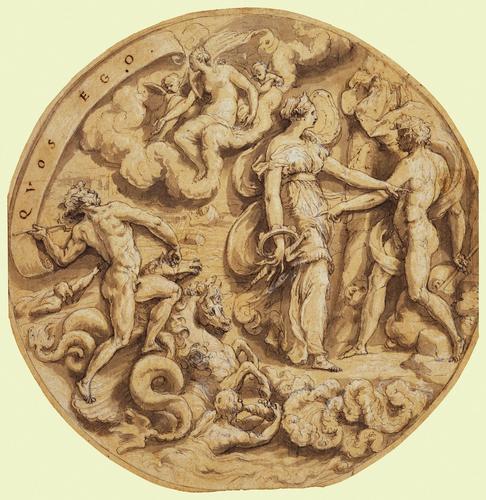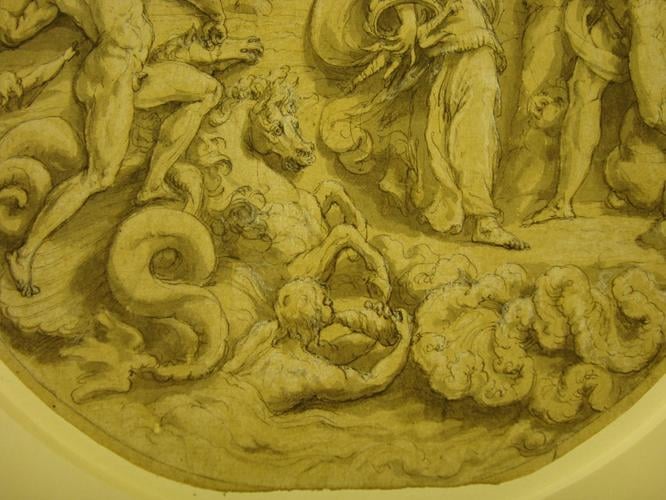Juno visiting Aeolus and Neptune calming the tempest 1540
Pen and ink with grey wash and white bodycolour, over black chalk on paper washed buff | 22.0 x 21.5 cm, circular (sides trimmed) (sheet of paper) | RCIN 905497

Perino del Vaga (Florence 1501-Rome 1547)
Juno visiting Aeolus and Neptune calming the tempest 1540

Perino del Vaga (Florence 1501-Rome 1547)
Juno visiting Aeolus and Neptune calming the tempest 1540

Perino del Vaga (Florence 1501-Rome 1547)
Juno visiting Aeolus and Neptune calming the tempest 1540

Perino del Vaga (Florence 1501-Rome 1547)
Juno visiting Aeolus and Neptune calming the tempest 1540

Perino del Vaga (Florence 1501-Rome 1547)
Juno visiting Aeolus and Neptune calming the tempest 1540

Perino del Vaga (Florence 1501-Rome 1547)
Juno visiting Aeolus and Neptune calming the tempest 1540







-
The drawing corresponds with a design described in great detail by the poet Annibale Caro, in a letter of 4 February 1540 to the medallist Alessandro Cesati at the Roman Mint (as first observed by M. Hirst, ‘Tibaldi around Perino’, Burlington Magazine, 1965, pp. 569-71). Caro was anxious to obtain a model for the reverse of a medal of his patron, Giovanni Guidiccioni (1480-1541), Bishop of Fossombrone. He had been offered a design by the crystal-engraver Giovanni Bernardi, but this was unsatisfactory and Caro wanted Cesati and Ludovico Fabri to devise a composition and get Perino to provide a drawing:
"[...] But before I forget, I wanted to tell you that in Faenza I have found Messer Giovanni [Bernardi] da Castel Bolognese, who is working on Cardinal Farnese's rock-crystals. Up until now he has made many things, but I don't know what to say about them. He proposed great things to me; nonetheless it seems that I should try to get the drawings by Perino that you told me about at our parting.[...] I wanted [Bernardi] to make me a little sketch for the reverse of the medal of the Bishop, but it is such that I am embarrassed to send it to you; however, I shall enclose it, since I desire to have a drawing by someone good, and I beg you to send me as soon as possible one from your hand or by Perino del Vaga.
"The idea is that of Virgil [Aeneid, 1:125-143], when by means of Aeolus, King of the Winds, Juno creates a tempest against the Trojans, and Neptune calms it. As regards the details: show on one side of the medal a grotto, such as you would imagine for the house of the Winds, at the mouth of which is their king Aeolus, who, sought out by Juno to turn the sea to a tempest, sends out all the Winds. They should be shown as figures or half-figures of men, with manes of hair and ruffled beards and puffed-out faces, with drapes held in each hand that also puff out like full sails, all beautifully arranged; and in various places gusts of wind should emerge from the cracks in the grotto to disturb the sea.
"If Messer Ludovico [Fabri] has by chance explained to you how Aeolus should be depicted, do as he tells you, if not, portray him in your own manner; however he should have the majesty of a king about his clothes, hair and beard, and some ribbons that seem thrown about by the Winds leaving the grotto. He should stand before Juno in a reverential attitude, and, if you think fit, with a bag in one hand, to allude to the story of Ulysses. Juno should face him like a queen, in sober clothes, with an imperious gesture and an evil face commanding Aeolus to generate the tempest. She should have a diadem on her head, that is, a band over her coiffure, and a cloak over her gown, gaiters at her feet, in her right hand a lightning-bolt, in her left a tambourine.
"In the other part of the medal should be Neptune with his chariot, his sea-horses and his trident in the usual manner, in the act of commanding the Winds and of quelling the tempest -- make this seem calm around him. And if it seems good to you, and the composition is not becoming too confused, add some nymphs swimming because of the calm, and a triton with a conch in his hand, or to his mouth, as you see fit. And with regard to the Neptune, you can, if it seems right to you, make use of the design of Leonardo da Vinci. [RCIN 912570]
"Above, on a little cloud, should be sat Venus, who should be small to indicate her distance, looking at Neptune as if the two of them had caused the calming of the sea. And as regards the phrase that comes forth from Neptune, I should like the grotto and Juno to be on the right hand side, Neptune on the left, and Venus above, closer to the grotto so that more space is left for the phrase between her and Neptune.
"I wanted to get this down in writing for you straight from my head, not to lay down the law to you or because you should do exactly as I say, but because you should have as your goal the subject as accurately as possible, and the composition should then be done as you think best; and you should lay it out as seems necessary to follow the story, and according to what the oracle Messer Ludovico tells you (beg him on my part that you should think it over together, but it will give me great pleasure if you can send it to me as soon as possible). Get Perino, or whomever comes to mind, to make sketches of it, and whichever turns out to be the most powerful invention, get it finished, or finish it yourself -- it would be a great favour if you could put it into wax, and I know how useful that would be to you too."
The present drawing must be Perino's final design for the medal. He tried valiantly to incorporate all the details prescribed by Caro, the only significant deviation being the form of the Winds, who are here merely rendered as a couple of blowing heads, rather than the many full- or half-length figures envisaged by Caro. The drawing did serve as the basis for Cesati's medal to Guidiccioni, but Perino's efforts were scarcely worthwhile -- the medal is only 29mm across and the details correspondingly indistinct, and while Cesati preserved the overall composition, Venus was reduced in size, Neptune turned around to face the viewer, and the figures of Juno and Aeolus completely altered (an example in the Pinacoteca Civica, Brescia, Mazzucchelli I.LXVI.1; repr. Clayton, Raphael and his Circle, 1999, p. 188).
Perino had depicted Neptune in the same pose, but in the opposite direction, in a drawing of the Shipwreck of Aeneas in the Louvre (inv. 636), probably a study for a destroyed mural painting in the Palazzo Doria, Genoa, of c.1528. The figure of Neptune in this was in turn based on a Raphaelesque composition of Neptune calming the tempest known through an engraving by Marcantonio Raimondi (Bartsch XIV, no. 352).
In a rough sketch by Perino of Neptune and his horses in the British Museum, two of the horses are very similarly posed (though in reverse) to the present design (Pouncey and Gere, Italian Drawings … in the British Museum. Raphael and his Circle, 1962, no. 169v). This is on the verso of a study of the Pool of Bethesda, datable around 1538-40, and it thus seems probable that the British Museum sketch is a study towards the present design. Hirst also noted that the figure of Juno is a quotation (in reverse) from Parmigianino's drawing of Circe and the companions of Ulysses (Uffizi 750-E, reproduced in an anonymous chiaroscuro woodcut, Bartsch XII, p. 110, no. 6). These sources and sketches are all in reverse with respect to the present drawing; perhaps Perino had not initially taken note of Caro's instruction to place Juno on the right and Neptune on the left, and was forced to reverse his design before executing this modello.
A same-size copy of the drawing is in the Biblioteca Reale, Turin (inv. 15801; Bertini 321).Provenance
First recorded in George III's 'Inventory A', c.1810, p. 53, Perino del Vaga, Baldre.Peruzzi, Nico:del Abatte etc, pp.2-5, probably one of "Four fine studies of Neptunes, Sea Horses, with Monsters, etc.. Perino del Vaga"
-
Creator(s)
(designer) -
Medium and techniques
Pen and ink with grey wash and white bodycolour, over black chalk on paper washed buff
Measurements
22.0 x 21.5 cm, circular (sides trimmed) (sheet of paper)
Other number(s)
Alternative title(s)
Quos Ego








